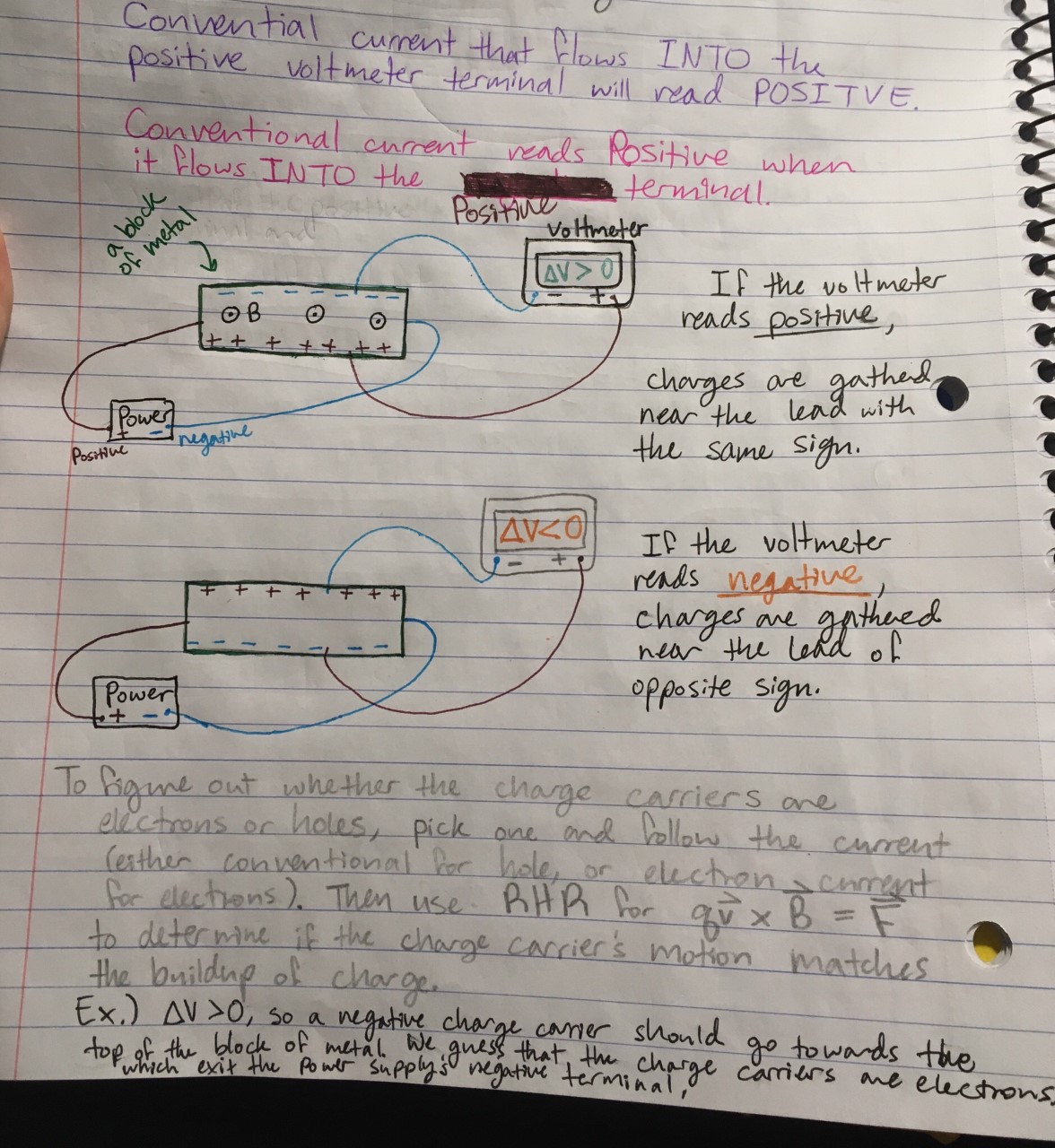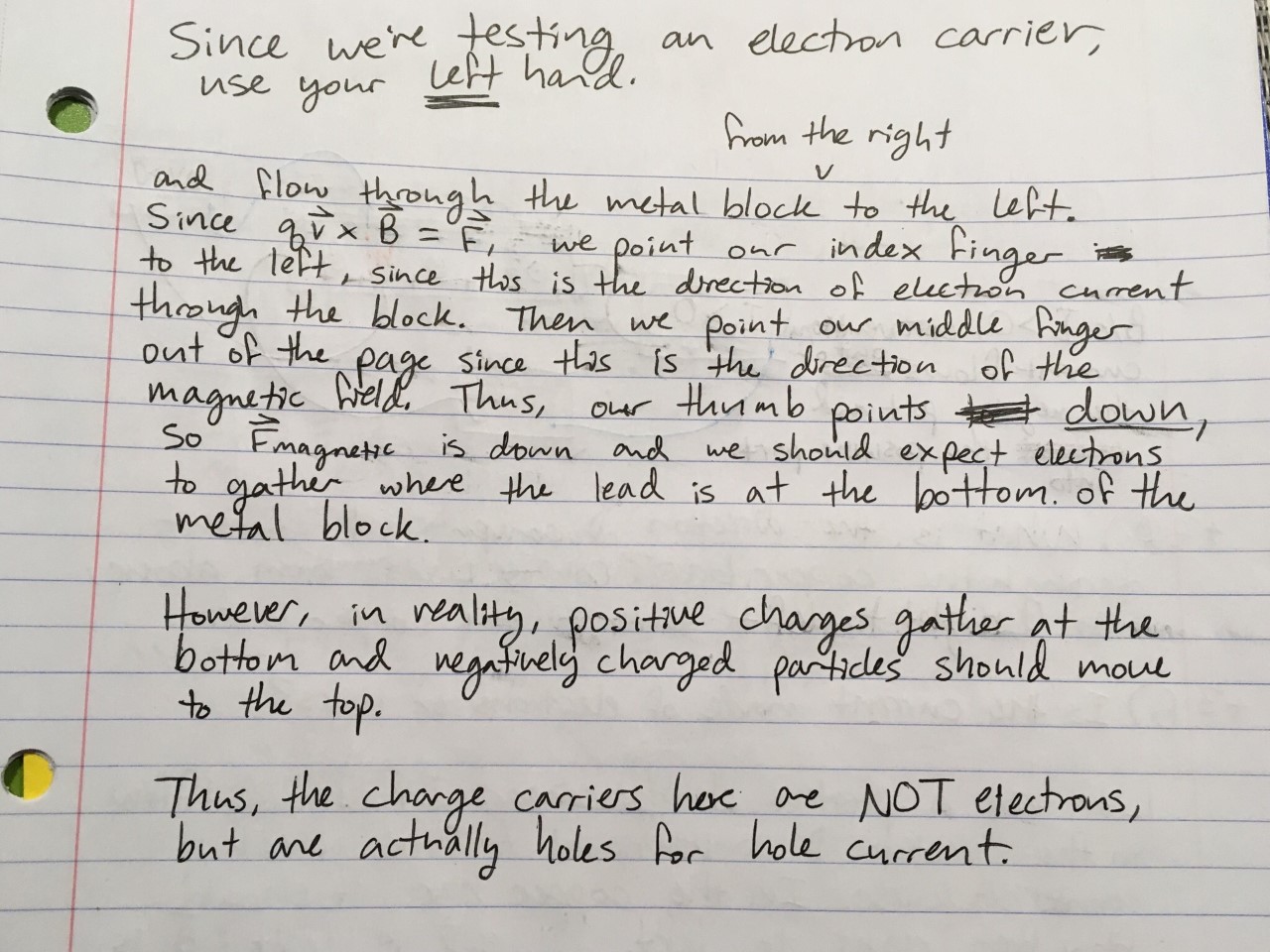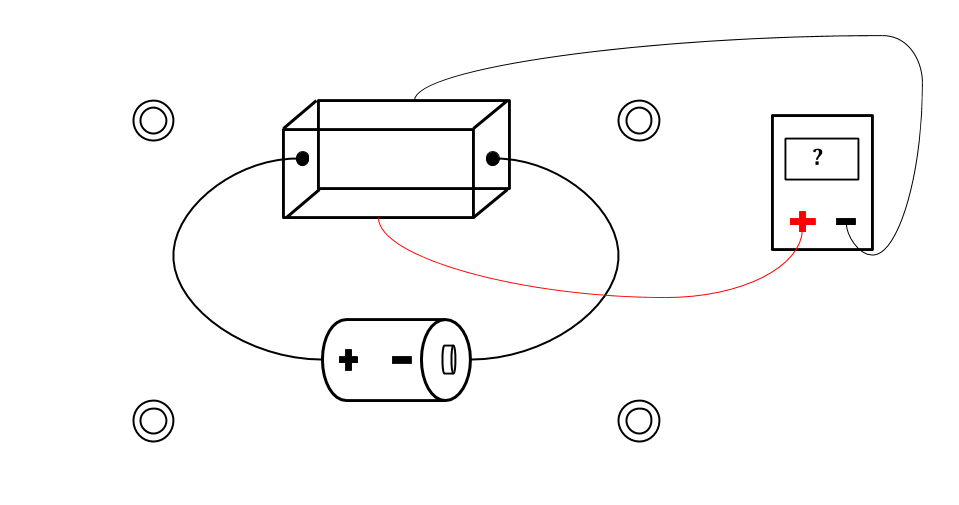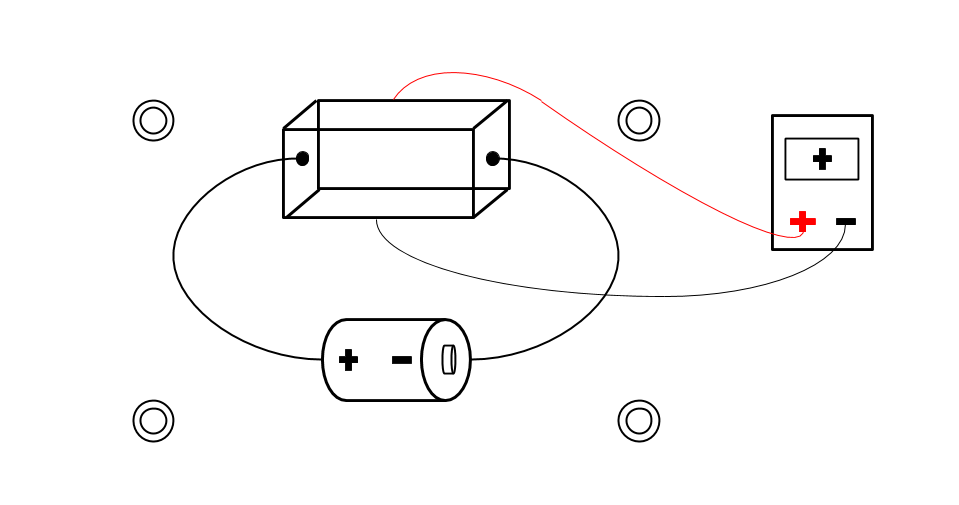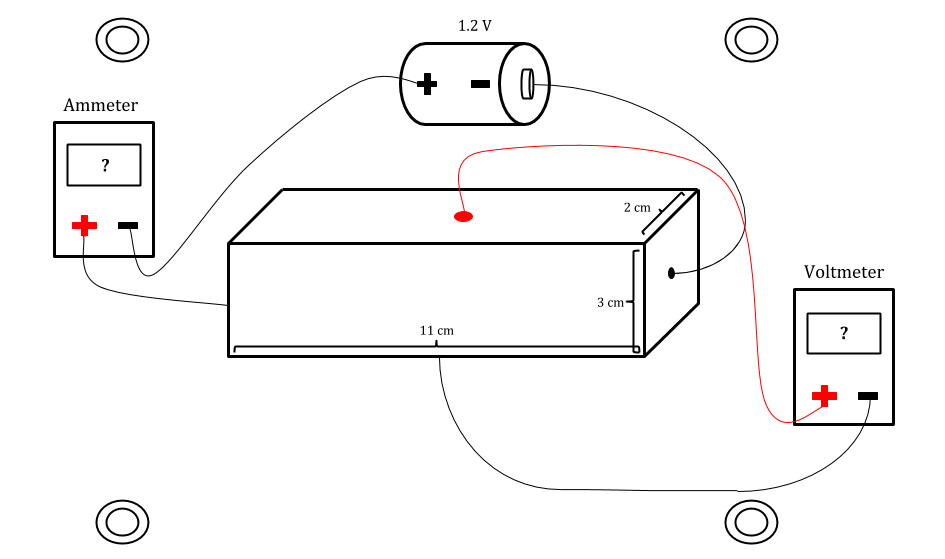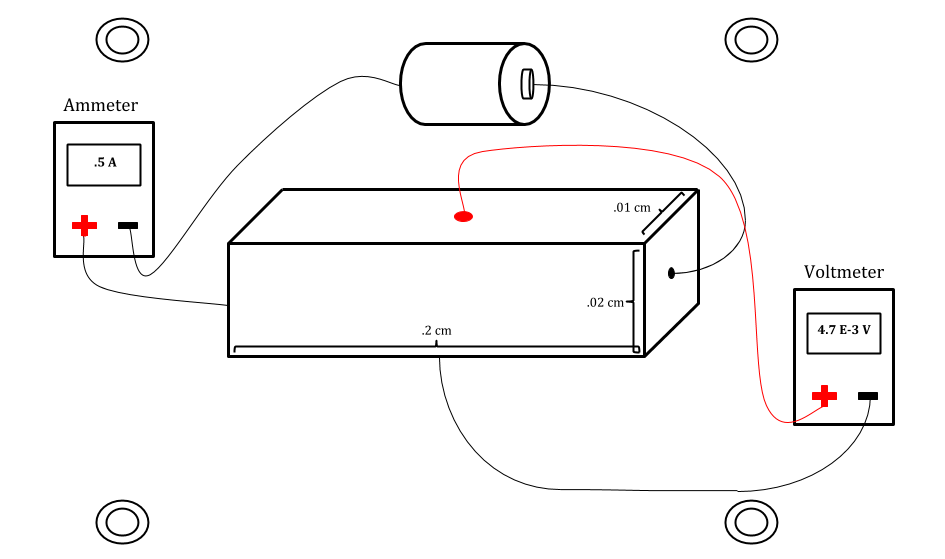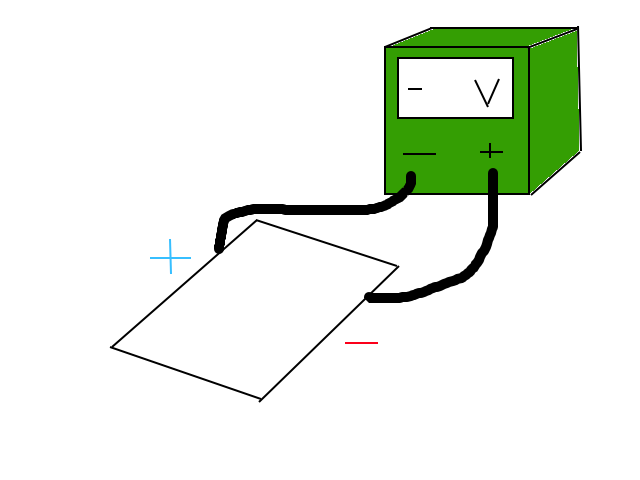Hall Effect
Edited by Adeline Boswell Fall 2019, Edited by Alayna Baker Spring 2020, Claimed by Nandana Avasarala (Spring 2025)
The Hall Effect is the electric polarization of a block or slab of metal that occurs when a current is run through it while it is subject to a magnetic field perpendicular to the current.
The Main Idea
When a mobile charge, either positive or negative, flows through a metal block and is influenced by a magnetic field, the magnetic force on the charges force them to begin concentrating on one side of the block. Thus the block polarizes and has negative charges on one side and positive on the other in order to remain neutral. This grouping of positive charges in one part of the block and negative charges in another part of the block creates an electric field and thus an electric force equal on magnitude to the magnetic force that causes the initial polarization, but opposite in direction. The magnetic and electric forces cancel each other out and after some time, the charges flow normally through the block and do not group on one side or the other of the block. This perpendicular electric field also creates a potential difference known as the "Hall Voltage."
Part 1: Normal circuit (No Magnetic Field Yet)
(For simplicity, the mobile charges in this example have already been determined to be negatively charged electrons. This will not always be the case and it should not be assumed that the mobile charges are electrons)
Mobile electrons flow through a wire due to a parallel electric field inside the wire. This electric field is caused by an energy source, most commonly a battery. The parallel electric field flows from an area of high potential (i.e. the positive end of the battery) to an area of low potential (i.e. the negative end of the battery). This is the same direction as the conventional current. Since electrons are negatively charged, they flow in the opposite direction of the parallel electric field.
Part 2: Initial Transient State (Magnetic Field Present)
Mobile electrons are subjected to a magnetic field perpendicular to their motion as they flow through the wire. This results in the mobile charges being forced onto one side of the block by the magnetic force. This grouping of mobile charges on one side of the block creates an electric force. As time passes, more mobile charges are deposited on the side of the block and the electric force increases in magnitude.
Part 3: Steady State (Magnetic Field Still Present, but abated)
Over time massive quantities of charges are concentrated on one side of the block. As the charges build up, they will begin to create a charged area on one surface of the conductor. The charged surface will create an electric force to oppose the magnetic force that is pushing new electrons onto this charged surface. This opposing electric force is called the transverse electric force. When enough mobile charges have collected, their combined transverse electric force will be equal in magnitude to the magnetic force that is holding them. At this point, there is no net vertical force pushing more electrons against the surface of the conductor and these electrons will flow normally again, as they would if there was no magnetic field present. This is called the steady state.
Extra: the Quantum Hall Effect
The quantum hall effect occurs in 2DES (2D Electron Systems) at very strong magnetic fields. 2DES are defined as materials where the electrons can only move in a 2D plane. As the magnetic field increases, there is resistance perpendicular to the material and parallel resistance due to the flow of electrons. As the magnetic field gets stronger, the parallel resistance begins to oscillate, while the perpendicular resistance begins to increase and then plateau. If the magnetic field is high enough, the value of the perpendicular resistance at these plateaus is constant.
A Mathematical Model
Part 1: Normal circuit (No Magnetic Field Yet)
[math]\displaystyle{ F_{electric, parallel} = qE_{parallel} }[/math]
Where q is the electric charge of the mobile charge. As F and E are vectors, a negative charge results in an electric force in the opposite direction of the electric field.
Part 2: Initial Transient State (Magnetic Field Present)
[math]\displaystyle{ F_{magnetic} = q(v\; Χ \;B) }[/math]
Where v is the velocity of the mobile charge and B is the magnetic field. For help calculating the cross product, including an example using the Hall Effect, see Right-Hand_Rule. REMEMBER, the mobile charge will move in the opposite direction of the cross product if it is negative, similar to how it behaves in an electric field.
Part 3: Steady State (Magnetic Field Still Present, but abated)
[math]\displaystyle{ F_{electric, perpendicular} = qE_{perpendicular} }[/math]
[math]\displaystyle{ |F_{electric, perpendicular}| = |F_{magnetic}| }[/math]
Computational Model
In this diagram, it is assumed the charge carrier is a negatively charged electron. THIS IS NOT A SAFE ASSUMPTION on a real question, experiment, or exam but was done for the purpose of simplifying explanations.
Part 1: Normal circuit (No Magnetic Field Yet)
In this diagram a solid conductive metal block is connected to two ends of a battery by wires. At this time there is no magnetic field present and electrons flow through the block in a straight line from wire to wire without interference or interruption.
Part 2: Initial Transient State (Magnetic Field Present)
In this diagram the circles containing x's represent a magnetic field (NOT a magnetic force) into the page. When the electrons begin to move across the block their initial velocity interacts with the magnetic field to create a magnetic force downward. This causes electrons to begin pooling on the bottom face of the slab. This polarizes the block and creates a vertical potential difference across the block. It also creates an electric force that opposes the magnetic force, but in this state it is smaller than the magnetic force, resulting in continued pooling of electrons.
Part 3: Steady State (Magnetic Field Still Present, but abated)
As time passes eventually sufficient quantities of electrons build up to create an electric force equal in magnitude to the magnetic force but opposite in direction. This allows the electrons to continue flow across the block as they did in part 1, however now the vertical voltage difference which was created in part 2 is not only still present but also at its maximum value. Most practice and exam problems will involve either the calculation or orientation of this voltage difference. It's important to remember that a voltmeter will have a positive reading if the positive node is connected to the end of the block which is positively charged and vice versa.
Examples
Simple
A metal block is connected to a battery by two wires. Conventional current flows clockwise and the mobile charge in the block is positive. The block also experiences a magnetic field out of the page denoted by concentric circles. The block is also connected to a voltmeter. The positive end of the voltmeter is connected to the bottom of the block and the negative end of the voltmeter is connected to the top of the block. See attached photo for a diagram. What sign will the voltmeter display?
Click for Solution
A battery and metal block are connected by 2 wires. Conventional current flows clockwise. A magnetic field points out of the page, denoted by concentric circles. A voltmeter is attached to the block with its positive lead at the top of the block and its negative lead at the bottom of the block. The voltmeter has a positive reading. What sign does the mobile charge have?
Click for Solution
An electron beam enters a crossed-field velocity selector with magnetic and electric fields of 2.0 mT and 6.0×103N/C, respectively. (a) What must the velocity of the electron beam be to traverse the crossed fields undeflected? If the electric field is turned off, (b) what is the acceleration of the electron beam and (c) what is the radius of the circular motion that results? (https://openstax.org/books/university-physics-volume-2/pages/11-6-the-hall-effect)
Click for Solution
Middling
[math]\displaystyle{ B = 1.8 T }[/math] out of the page (denoted by concentric circles)
[math]\displaystyle{ n = 7*10^{25} /m^3 }[/math]
[math]\displaystyle{ u = 3*10^{-5} }[/math]
- What does reading does the voltmeter display (both magnitude and sign)?
- What does reading does the Ammeter display(both magnitude and sign?
Click for Solution to #1
Click for Solution to #2
Difficult
[math]\displaystyle{ B = 1.5 }[/math] T out of the page (denoted by concentric circles)
- Calculate the drift speed v of the mobile charges
- Calculate the charge density n of the mobile charges
- ∆V = 13 V along the length of the bar, calculate the mobility u of the mobile charge carrier in the metal
Click for Solution to #1
Click for Solution to #2
Click for Solution to #3
Applications
Hall effect is all about seeing the relationship between magnetic and electric forces while also remembering how metals polarize. This means that it has a lot of mechanical and machine applications. It can sense when a magnetic field or electric field changes, so it can control many machines, apply pressures, and report many values. All of these skills are very important for Mechanical Engineering, so this topic has a lot of relevance to my major. Moreover, a lot of engineering, in general, is about analyzing concepts before calculating values. The idea of the Hall Effect gives a lot of important data without the use of any numbers (of course it gives more info on the calculation of numbers). This reasoning process required for the Hall Effect is a very helpful skill for engineers to have.
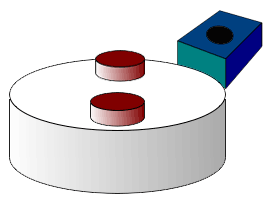
Another field that takes advantage of the Hall Effect is Electrical Engineering thanks to the Hall Effect Sensor. Electrical engineers can use the hall effect sensor to record movement. As seen in the picture to the left, the sensor will increase its voltage the closer the magnet is to the sensor. In fact, a VIP group here at Georgia Tech, the VIP Hands-on Learning team, researched the possibility of using the sensor to measure the movement of a two-degree of freedom spring-mass system. Links to the VIP Research: https://vip.gatech.edu/wiki/index.php/Vibrations https://vip.gatech.edu/wiki/index.php/Hall_Effect_Sensor
Industrial
Hall Effects are used in industry to aid in the control of Hydraulic systems such as moving cranes and backhoes. It is also used to help sense a car wheel's motion to aid in the use of anti-skid/anti-lock brakes. Every smartphone today uses a hall effect sensor as well. This is how the digital compass of a cell phone works. The hall effect senses the change in magnetic field to approximate direction. Another great way of using the hall effect in smartphones is to lock the screen when a case cover is flipped. The cover has a magnet that the smartphone senses, so it locks the screen automatically when the cover is on the screen. A test for this feature can be seen in the following video: https://www.youtube.com/watch?v=ITbT5vrvhX8 .
Hall effect sensors, and their ability to sense changes in position, have a wide variety of uses in the automotive industry. Hall effect sensors are used in ignition timing, where a permanent magnet and semiconductor Hall Effect chip are placed side-by-side separated by a gap; together, they make a hall effect sensor in the car. A metal rotor is positioned so that the shafts of the rotor specifically go through the gap between the chip and the magnet, and the sensor detects the position of the rotor depending on whether the magnet is shielded from the chip (depending on what passes through the air gap). The sensor sends this signal to the engine computer, which in turn determines the ignition.
Hall effect sensors are also used by some 3D printers to calculate the filament thickness. It is able to detect changes in the position of different elements of the 3D printer. Hall effect magnetometers, also known as Hall effect probes, are used to inspect for corrosion in tubing and pipelines using magnetic flux leakage. Magnetic flux leakage is the principle that in a steel structure with corrosion or pitting, the magnetic field will "leak" out anywhere there is metal missing. The Hall Effect probes use a specially calibrated Hall Effect sensor to measure the strength of the magnetic field, and the results are dependent upon the orientation of the probe.
Laboratory
Hall effect is also taken into consideration when hall probes are used as magnetometers.
A Hall probe is used to measure the difference of magnetic flux perpendicular to its sensor. This information is then fed to magnetometers to help read the difference in magnetic fields.
Hall effect sensor: http://www.ebay.com/sch/i.html?_nkw=hall+effect+sensor
To use this idea in a lab, simply create a circuit through a conductive material, like a piece of foil, and calculate the direction of the magnetic field using right-hand rule. Use this information to then properly add the hall probes to the foil so they are perpendicular to the magnetic field, and then BOOM! You will have information to read to a magnetometer.
History
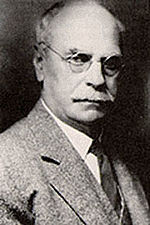
The Hall Effect was discovered in 1879 by Edwin Hall while attending Johns Hopkins University for his Doctoral Degree. While a solid mathematical groundwork for electric and magnetic phenomenon had already been discovered by James Clark Maxwell, many of the physical implications and practical uses for these theories was still being explored. The interaction of magnetic and electric fields was a particularly hot topic. Hall exposed a gold leaf (metal slab) to a magnetic field perpendicular to its surface and had current flow through the slab. He observed a potential difference perpendicular to the current and also the magnetic field. This means that potential is observed not only in the direction of current flow as usual. This is what led to Hall's discovery of the Hall Effect, originally published in his paper "On a New Action of the Magnet on Electric Currents".
The Quantum Hall Effect was discovered in 1980 by Klaus von Klitzing, who won the Nobel Prize in 1985 for his work. He studied the movement of electrons in a 2D context between two semiconductors, and he found that when graphing the Hall Resistance vs. the field strength, the plot was not linear but instead resembled a staircase, with plateaus. The discovery that these plateaus represented some integer multiplied by a constant, meaning that they are quantized, revolutionized the field and became a standard of electrical resistance.
Conclusion: Tips to remember
1. When a current carrying metal/conductor is placed in a magnetic field, a voltage is formed perpendicular to both current and magnetic field
2. The Hall effect is made when the charges create almost a polarized metal, as a result of being subject to a magnetic field perpendicular to the flow of electrons.
3. Right-hand rule whenever in doubt.
Hall effect can only be tested so many ways. There are a few tricks to keep in mind.
In the diagram above a voltmeter connected to a sheet of metal. Since the voltmeter reads a negative voltage, you can automatically assume that the side connected to the negative terminal of the voltmeter is connected to the positive side of the metal due to hall effect, because voltmeter is reading a charge in the opposite direction.
See also
Are there related topics or categories in this wiki resource for the curious reader to explore? How does this topic fit into that context?
Combining Electric and Magnetic Forces
Further reading
Books, Articles or other print media on this topic
Matter and Interactions: Volume 2 by Ruth Chabay and Bruce Sherwood (4th Edition)
http://www.phys.utk.edu/labs/modphys/Hall%20Effect.pdf
External links
Internet resources on this topic
http://hyperphysics.phy-astr.gsu.edu/hbase/magnetic/hall.html
https://www.youtube.com/watch?v=_ATDraCQtpQ
References
https://en.wikipedia.org/wiki/Hall_effect
http://www.nobelprize.org/nobel_prizes/physics/laureates/1998/press.html
https://en.wikipedia.org/wiki/Edwin_Hall
Matter and Interactions: Volume 2 by Ruth Chabay and Bruce Sherwood (4th Edition)
http://www.nasonline.org/publications/biographical-memoirs/memoir-pdfs/hall-edwin.pdf
http://www.electronics-tutorials.ws/electromagnetism/hall-effect.html
https://www.quora.com/What-is-the-use-of-Hall-effect-sensors-in-smartphones



